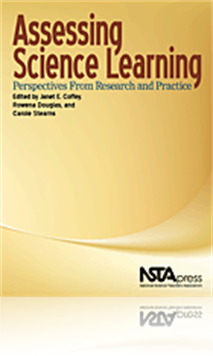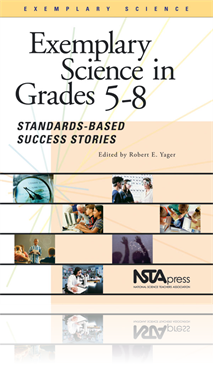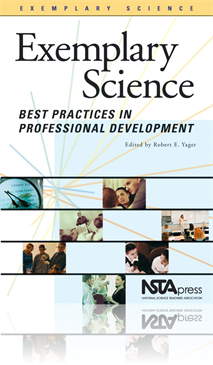All Resources
Book Chapter
This lab is not an inquiry activity. Without a motion sensor, the students cannot determine independently that the final velocity is double the average velocity. This activity does, however, make this concept concrete in their minds. By doing only wo...
Book Chapter
This activity is inquiry in that students cannot locate or define center of percussion before the lab. Even though it appears to students that the point of this lab is to find the center of percussion, the real point is to learn about the period of a...
Book Chapter
In this inquiry activity, students will discover the relationship between length and pitch (frequency), tension and pitch, and mass per unit length and pitch without being instructed first. Many students confuse pitch and volume, so the teacher may h...
Book Chapter
This lab introduces students to refraction using something they can experience. They really do not understand what is going on when a pencil is put into water and appears to bend. It is difficult to see rays of light bending without the use of a lase...
Book Chapter
This inquiry activity will be students’ first exposure to ray diagrams. They will be using the refraction of sound to simulate the refraction of light to introduce them to this concept. They will be creating a simulated convex lens with a CO2-fille...
Book Chapter
This is the first time that students will draw technical ray diagrams (in previous experiments, they simply sketched the rays). They need a little instruction in drawing ray diagrams before they can do it, so the activity is not purely inquiry. But i...
Book Chapter
This inquiry activity will be used before discussing curved mirrors in class. Students will discover how curved mirrors act and how the size and the orientation of the image are related to the distance from the mirror. Ray diagrams for curved mirrors...
Book Chapter
This activity is inquiry in that students do not know how colors are combined. They likely think that the primary colors are red, yellow, and blue. In fact, there are two sets of primary colors: red, green, and blue for additive colors of light, and ...
Book Chapter
Although this lab is not an inquiry activity, it is another exercise to help students think about light rays and ray diagrams. The students think that the point of the lab is to calculate the diameter of the Sun. Really, the point is to get used to t...
Book Chapter
This activity is Level 2 inquiry in that students will not know in advance that the relationship is inverse square. Although they may not get a perfect inverse square graph, it will be clear that it is not a perfect straight line. This activity can a...
Book Chapter
In this inquiry activity, students will discover some of the rules of reflection of water waves, how waves travel around boundaries, and how waves move floating objects before they have learned these concepts. If students have difficulty seeing the w...
Book Chapter
This lab is a Level 2 inquiry activity that should be taught after students understand acceleration but before they learn the equations for calculating the acceleration of a body dropped from a certain height. After this activity, students should und...
Book Chapter
Students will once again be reminded of the inverse square nature of light intensity. This is a concept that students often struggle with, especially when calculations are involved. The important idea of this lab is not to actually figure out the wat...
Book Chapter
This activity is inquiry in that students have not yet studied interference or interference patterns. Students without a computer at home should be instructed as where they can go to use a computer with speakers that will allow them to install softwa...
Book Chapter
In this inquiry activity, students will get some experience with static electricity before getting deep into electricity and magnetism. They will not know which combinations will generate static electricity and will test some materials of their own c...
Book Chapter
In this lab, students will experience the interaction of charged objects. Students should realize that the phrase “opposites attract” isn’t exactly correct. It is not just positively and negatively charged objects that are attracted. Positively...
Book Chapter
This inquiry activity is performed before students understand the difference between current and voltage. Students also determine the procedure themselves and design the data chart and graph on their own. This makes it Level 3 inquiry. The lab introd...
Book Chapter
This activity is inquiry-based in that students will perform the activity before they formally learn about how objects can become charged with static electricity (induction, contact, etc.). This will allow the teacher to refer to this activity when t...
Book Chapter
The number of batteries used in this lab is determined by the type of lightbulbs that are used. A 3 V lightbulb will require two batteries. Students should perform this activity after being instructed how to use the multimeter. Instructions will vary...
Book Chapter
An LED should never be connected directly to a battery or it will be damaged. A current-limiting resistor must be attached to either leg to prevent this damage. The value of the resistor will depend on the battery that you use and the LED that you us...
Book Chapter
This activity is inquiry-based in that students will perform the activity before they formally learn about how a switch works. They will use a multimeter to discover the different settings on a triple-throw switch. The teacher should show the student...
Book Chapter
This lab is between a Level 2 and Level 3 inquiry activity in that it should be assigned after students understand acceleration but before they learn about the acceleration gravity. Because there are many sources of error when using a pendulum, stude...
Book Chapter
In this investigation, students will construct electromagnets and test to see which variables make them stronger. Although elementary and middle school teachers are expected to have done this activity with their classes, teachers of younger students ...
Book Chapter
This activity will introduce students to the idea of magnetic field lines—a concept they have probably encountered but may not fully grasp. Completing this activity and reading the corresponding background information should enable students to unde...
Book Chapter
Resistance is how much an object resists the flow of electrons. This depends on the material (its resistivity) and the size and shape of the sample being tested. In this lab, students will determine whether resistance is directly or indirectly relate...
Book Chapter
Students can easily see what series resistance means in this activity. Students are sometimes confused by the fact that all real resistors are the same size even when they have far different values. It is recommended that after this lab at home, stud...
Book Chapter
Students will measure the resistance of resistors that they have drawn on paper with a graphite pencil. They will then connect two resistors in parallel and measure the resistance of the combination. In this activity, it is important that students co...
Book Chapter
It is important for students to understand how resistors, capacitors, and batteries combine in series and parallel. The combination of batteries has a lot of practical applications in science competitions. This lab also reinforces how to use a voltme...
Book Chapter
This lab is not an inquiry activity. There are some students whose reaction times will not allow them to catch a 12 inch ruler. They may use a dowel, stick, strip of cardboard, etc. Although the students are led to believe that the point of the lab i...
Book Chapter
This lab is an inquiry activity in that students have not been exposed to the idea of terminal velocity, though they are using skills that they already have to analyze the balloon’s motion. The lab is both a review of graphing and translating dista...
Book Chapter
This inquiry activity is used after students have learned how to calculate kinetic and potential energy but before they learn about conservation of energy. It is important for students to repeat the measurement three times because it is not easy to m...
eBook
Take-Home Physics: 65 High-Impact, Low-Cost Labs (e-Book)
Take-Home Physics is an excellent resource for high school physics teachers who want to devote more classroom time to complex concepts while challenging their students with hands-on homework assignments. This volume presents 65 take-home physics labs...
eBook
Assessing Science Learning: Perspectives From Research and Practice (e-book)
This book contains many essays and multiple examples of meaningful science assessment practices they explore. The collations of essays reflect work with socioeconomically and ethnically diverse populations to better understand the attributes of equit...
eBook
Exemplary Science in Grades 5-8: Standards-Based Success Stories (e-book)
Do the Standards really matter in middle school? Nine years after the National Science Education Standards’ release, just how well do science teachers in grades 5 to 8 actually use them to plan content, define improved teaching, and assess real lea...
eBook
Exemplary Science: Best Practices in Professional Development (e-book)
This collection of 16 essays is ideal for staff development providers (university faculty, district supervisors, lead teachers, and principals) as well as preservice science methods instructors. Each essay describes a specific program designed to tra...
NSTA Press Book
Activities Linking Science With Math, K-4
Science does not exist in a vacuum and, therefore, shouldn’t be taught that way. In that spirit, Activities Linking Science With Math, K-4, is a hands-on guide for preservice and inservice elementary school teachers who want to connect science inst...
By John Eichinger






